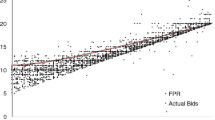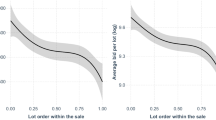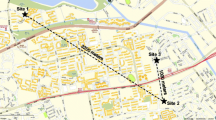Abstract
Bid skewing is a potential issue when timber is sold at scale-bid auctions and the seller’s timber-cruise estimate is used for bid evaluation. I illustrate the problem and its potential effect on seller stumpage revenue, and then quantify the impact of species-specific reserve prices as well as species-specific bid caps using data gathered from 41 Wisconsin State forestry auctions.
Similar content being viewed by others
References
Athey S, Levin J (2001) Information and competition in U.S. forest service timber auctions. J Political Econ 109: 375–417
Baldwin L, Marshall R, Richard J-F (1997) Bidder collusion at U.S. forest service timber sales. J Political Econ 105: 657–699
Donald S, Paarsch H, Robert J (2009) An empirical model of the multi-unit, sequential, clock auction. J Appl Econom (in press)
Government Accounting Office (1983) Skewed bidding presents costly problems for the forest service timber program. Report RCED-83-87, February
Haile P (2001) Auctions with resale markets: an application to U.S. forest service timber sales. Am Econ Rev 92: 399–427
Haile P, Tamer E (2003) Inference with an incomplete model of English auctions. J Political Econ 111: 1–51
Haley M, Paarsch H (2004) The stochastic implications of rent maximization: an application to stumpage rates for timber in British Columbia. J Appl Econom 19: 25–48
Leffler K, Rucker R (1991) Transaction costs and the efficient organization of production: a study of timber-harvesting contracts. J Political Econ 99: 1060–1087
Manski C (1995) Identification problems in the social sciences. Harvard University Press, Cambridge
Munn I, Rucker R (1995) An economic analysis of the difference between bid prices on forest service and private timber sales. For Sci 41: 823–840
Paarsch H (1992) Deciding between the common and private value paradigms in empirical models of auctions. J Econom 51: 191–215
Paarsch H (1993) The effect of stumpage rates on timber recovery. Can J Econ 26: 107–120
Paarsch H (1997) Deriving an estimate of the optimal reserve price: an application to British Columbia timber sales. J Econom 78: 333–357
Paarsch H, Shearer B (1999) The response of worker effort to piece rates: evidence from the British Columbia tree-planting industry. J Hum Res 35: 1–25
Author information
Authors and Affiliations
Corresponding author
Rights and permissions
About this article
Cite this article
Haley, M.R. Bounding revenue leakages at scale-bid timber auctions: evidence from Wisconsin state forest auctions. Empir Econ 39, 427–437 (2010). https://doi.org/10.1007/s00181-009-0311-9
Received:
Accepted:
Published:
Issue Date:
DOI: https://doi.org/10.1007/s00181-009-0311-9




